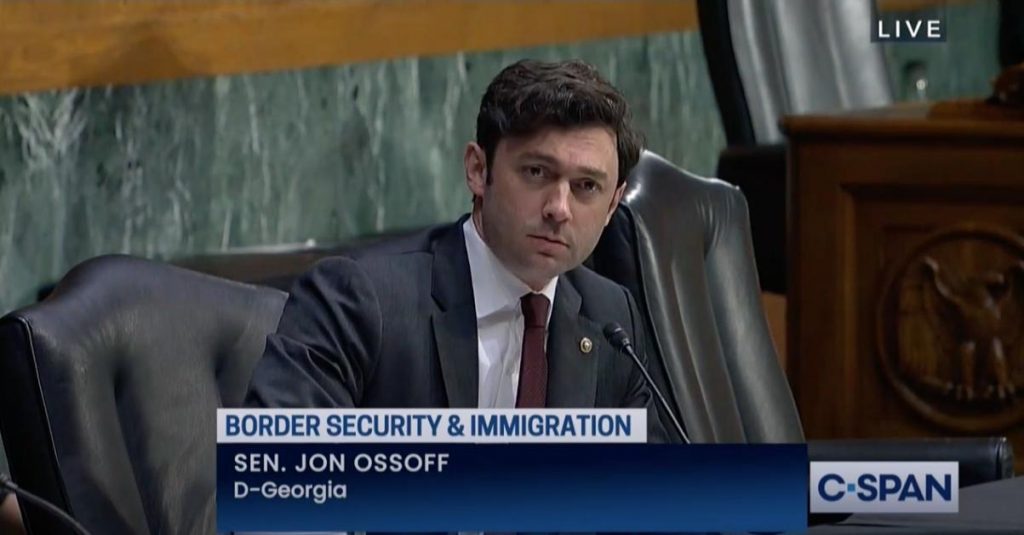Washington, D.C. – U.S. Senator Jon Ossoff is pushing the Biden Administration to strengthen border security along the Southern border.
In a U.S. Senate Homeland Security Committee hearing today, Sen. Ossoff pressed Maryann E. Tierney, FEMA Regional Administrator and recent Senior Coordinating Official of the Southwest Border Coordination Center, to detail the Administration’s plans to manage a projected influx of migrants into the U.S. this summer.
Sen. Ossoff pressed Tierney for details, specific measures, and preparations in place to handle the anticipated surge of attempted unauthorized border crossings, as well as on how the Department of Homeland Security plans to measure the success of their operations.
Click here to watch Sen. Ossoff’s line of questioning:

Please find a transcript of the exchange below:
SEN. OSSOFF: “Ms. Tierney, the United States must know and control who enters and exits our territory. That’s a basic condition of sovereignty. The Department expects, does it not, a significant increase in attempted unauthorized entry along the Southern border this summer?”
TIERNEY: “Sir, the DHS Office of Immigration Statistics has published projections that show an increase in irregular migration post Title 42.”
SEN. OSSOFF: “Is the Administration prepared for this anticipated surge in attempted crossing?”
TIERNEY: “Senator, thank you for that question. We have identified the needed requirements to meet the different levels of our planning assumptions, and we are actively working to both resource physical assets as well as policies and improvements to processing, to meet those increased surges.”
SEN. OSSOFF: “Thank you, Ms. Tierney. But my question is a simpler one. It’s: is the Administration prepared?”
TIERNEY: “Well, sir, I think since some of these projections are higher than what CBP has seen previously, you know, I think we are doing prudent planning. We are using the planning to identify the resource requirements that would be needed based on what experts like Chief Hoffman and others identify as the need. We’re working to improve policies. So I think we are readying ourselves and we are going to be as ready as we can be, come May 23.”
SEN. OSSOFF: “If you’re not able to confidently state that the Administration is prepared, what are the requirements that are unmet? Have you sent, for example, a request for a supplemental to Congress? If you’re not prepared, what’s it going to take to get prepared? Because my constituents lack confidence that sufficient preparation is ongoing, and that the Administration is prepared. So if you’re not prepared, what do you need?”
TIERNEY: “Well, sir, I would not say that we are not prepared. What I would say is that we are preparing based on projections, based on requirements identified by experts. We are resourcing against those requirements, and we will have the necessary items in place for May 23. Now, again, I’ve been an emergency manager for quite some time, you know, I never feel like we’re prepared enough. I always want to be more prepared than we need to be. And so we are doing everything we can to be ready. We have been working furiously, really since the Fall of 2021 to get ready. We are more ready now than we were yesterday. And we will certainly be more ready on May 23 than we are now.”
SEN. OSSOFF: “Thank you, Ms. Tierney, how will you measure success?”
TIERNEY: “So we have identified, for each of our major agencies, items that would indicate stability. So like, for example, with Customs and Border Protection, the Southwest Border Coordination Center has identified a stability goal for Border Patrol that is having twice as much holding as we have encounters over a 48-hour period. So for example, if the Border Patrol is seeing about 6,000 to 7,000 counters a day, which is what they’re generally seeing right about now, then you would want to have about 13,000 to 14,000 holding spaces available. And I think that’s an indicator of what the system can absorb and process through in about a 48-hour period.”
SEN. OSSOFF: “Thank you, Ms. Tierney. My time is limited. I’d like you to walk me through several of the other metrics, or qualitative assessments, that you’ll use to measure success. So you say you’re preparing, and I acknowledge that that work is ongoing. How will you measure whether that preparation has been effective? You mentioned holding capacity relative to encounters. What are the other measures of success?”
TIERNEY: “So time in custody would be another measure of success. Also, you know, the ability to decompress Border Patrol stations through lateral movement, and some of the other options that we have identified like mobile in-route processing. Again, so you know, monitoring the capacity of the individual sectors, identifying sectors that are over capacity, and then being able to flex to address that over capacity.”
SEN. OSSOFF: “Thank you, Ms. Tierney.”
###